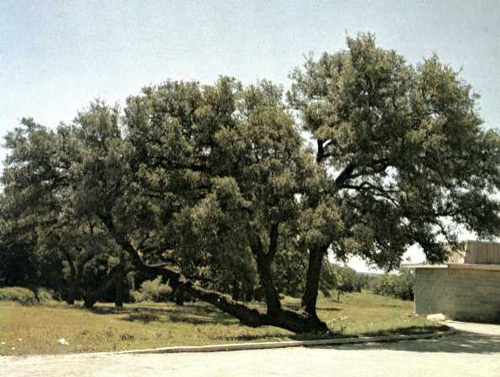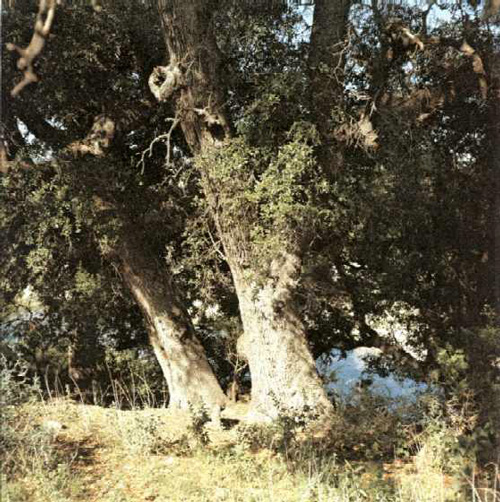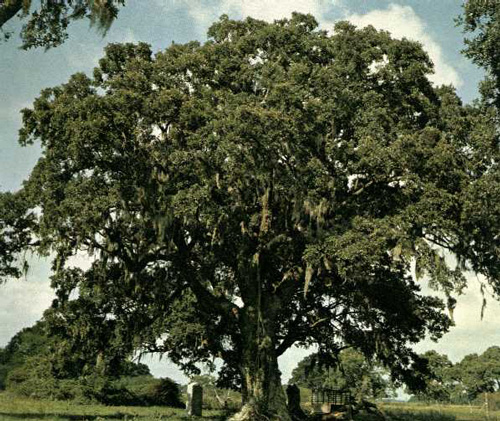ABOUT LIVE OAKS
Quercus fusiformis was described and the name validly published by John Kunkel Small in 1903.

John Kunkel Small, 1869-1938
From 1897-1933, Small split Q. virginiana into several additional species (e.g. Q. minima (Sargent) Small, and Q. fusiformis). However, Charles Sprague Sargent disagreed with Small and reduced Q. fusiformis to a varietal rank under Q. virginiana.

Charles Sprague Sargent, 1841-1927
In 1961, Cornelius Muller supported species recognition for Q. fusiformis. Muller reported acorn morphology as the major separation between Q. virginiana and Q. fusiformis. Muller also reported morphological integration between Q. virginiana and Q. fusiformis.

Cornelius Herman Muller, 1909-1997
Kevin C. Nixon reported that populations of Q. virginiana were limited to south and east Texas, whereas Q. fusiformis populations were generally located in the central area of Texas from the coastal plain to the Edward's Plateau. He further reported introgression between Q. fusiformis and Q. virginiana on the Edward's Plateau that resulted in populations that consist of complex mixes of hybridization between the two species. "The populations of live oak that occur in the area bounded by Columbus, Austin, and San Antonio, Texas can all be considered morphologically intermediate between the populations of Quercus fusiformis that occur on the Edward's Plateau and Quercus virginiana of coastal southeastern Texas".

Kevin C. Nixon, 1953- , Cornell University
Previous research using hybridization studies between Q. virginiana and Q. fusiformis was conducted by H. Ness and by James Hardin. They both concluded that Q. virginiana and Q. fusiformis were one species that adopted different growth patterns in different environments.


James Walker Hardin, 1929- , North Carolina State University Helge Ness, 1861-1928, Texas A&M University
Presently Q. fusiformis and Q. virginiana are treated as two separate species with the ability to freely hybridize.
NATIVE RANGE OF QUERCUS VIRGINIANA


The following excerpts are available for anyone to view free online:
According to Turner's Atlas of the Vascular Plants of Texas, Vol. 1, in Texas Q. virginiana occurs only as far west as eastern Williamson County and eastern Bell County. The majority of the occurrences are east and south of Bell County, mostly clustered along the Gulf Coast. Quercus fusiformis, on the other hand, occurs mainly west of the line of counties including McLennan, Bell, Williamson, Travis, Hays, Comal and Bexar- generally, the Edwards Plateau. There is also a grouping in the southern tip of Texas in the South Texas Plains. Additionally, there is an eastern line of counties (including Goliad, DeWitt, Lavaca, Colorado, Fayette, Bastrop, Washington and Brazos) where Q. fusiformis and Q. virginiana overlap. In its eastern range and especially where the two overlap, is where the confusion abounds.
Robert A. Vines refers to fusiformis by the common name "Scrub Live Oak" which he describes as a shrub or small tree to 36' tall, noting that "some authors prefer to maintain it as a western, more shrubby variety of Live Oak. Although it appears distinct in the western part of its distribution (beyond the Edwards Plateau area and into Mexico), on its eastern range it seems to pass into Q. virginiana with many intermediary variants."
Benny Simpson says this about Q fusiformis:
"Escarpment Live Oak grows in mottes, attaining heights of 50 feet on almost any alkaline to slightly acid, well-drained soil. It is rather rare on the the true Blackland Prairies, possibly because of the poor internal drainage of those soils, but it does occur in the West Cross Timbers and Grand Prairie, west and north of the Balcones Escarpment on the Edwards Plateau, and, to a lesser degree, east of the Balcones Fault Line on the Blackland Prairies. It grows in hybrid swarms of Quercus virginiana x Q. fusiformis from the Balcones Escarptment to the coastal area and then eastward to the Brazos River, where, on the east side, more or less pure forms of Q. virginiana are encountered."
From Flora of North America:
"The difficulty in distinguishing Texas populations of Quercus fusiformis from Q . virginiana is reflected in a variety of taxonomic treatments, including reducing Q . fusiformis to varietal rank under Q . virginiana . The latter disposition is problematic, however, because Q . fusiformis in northeastern Mexico is amply distinct from Q . virginiana and appears to be more closely related to Q . brandegei Goldmann, an endemic of Baja California, Mexico. Thus, here we assume that the intergradation of Q . virginiana and Q . fusiformis is a result of secondary contact, and is not primary clinal variation. Under this interpretation, Q . virginiana in typical form extends into Texas only as far west as the Brazos River drainage along the coast from there to the escarpment of the Edwards Plateau; most populations elsewhere are either intermediate between the two species or show greater affinity with Q . fusiformis . On the Edwards Plateau, the live oak populations are small trees forming rhizomatous copses (shinneries) and having mostly acute acorns."
Described from Ladybird Johnson Wildflower Center UT website wildflower.org plant database: Plateau oak or Escarpment live oak is a thicket-forming shrub or large, spreading tree that is nearly identical in appearance to, and considered much hardier than, Q. virginiana. A short, tapering trunk supports picturesquely gnarled branches and limbs that over time will spread horizontally a great distance from the main trunk. It can reach a height of 20-40 ft. (72') Leaves are evergreen, firm textured, ovate to elliptic, 1 to 3 inches long; usually without lobes except on young plants and rootsprouts, then with pointed lobes. The leaves are generally slightly smaller than those of Q. virginiana. Acorns 3/4 to 1 inch long, rather elongate. Unlike Coastal live oak, acorns are spindle-shaped (fusiform), narrowed at the base.
Ranging from the Glass Mountains and Arbuckle Mountains of southern Oklahoma south through the center of Texas to the mountains of Coahuila, Tamaulipas, and Nuevo Leon in Mexico, Quercus fusiformis is the common live oak used in landscaping and found in the wild in central Texas. It is more drought-tolerant and cold-hardy than Q. virginiana, which it is sometimes considered a variety of. Like Q. virginiana, its magnificent, stately form has endeared it to generations of residents and it remains popular to this day. Also like Q. virginiana, it is susceptible to live oak wilt and live oak decline when stressed by drought, so care must be taken to protect it from injury both above ground and below ground to prevent infection.
Phylogeny and biogeography of the American live oaks (Quercus subsection Virentes)
FROM TEXAS A&M WEBSITE FAMOUS TREES OF TEXAS
ALL OF THESE TREES IDENTIFIED AS QUERCUS FUSIFORMIS:
BELL COUNTY CHARTER OAK TREATY OAK AUSTIN RIO FRIO LANDMARK OAK TRADERS OAK FORT WORTH HALFWAY OAK BRECKENRIDGE

.jpg)


.jpg)
FLEMING OAK COMANCHE
ELECTION OAK CLIFTON
CENTER OAK GOLDTHWAITE
HANGMAN'S OAK BANDERA
INDIAN MARKER TREE BURNET





KIMBLE COURT OAKS
COMMISSIONERS COURT OAK
HEART O TEXAS OAK
CHOCTAW ROBINSON OAK
AUCTION OAKS AUSTIN




.jpg)
MATRIMONIAL OAK SAN SABA
SEIDERS OAKS TRAVIS COUNTY
TURNER OAK TARRANT COUNTY
TWIN OAKS HAMILTON COUNTY
FOUNDERS OAK COMAL COUNTY
.jpg)
.jpg)

.jpg)
.jpg)
BURGES OAK EL PASO
YOUNG COUNTY OAK
ALAMO MISSION OAK
BOSQUE COUNTY OAK




ALL OF THESE TREES IDENTIFIED AS QUERCUS VIRGINIANA:
BURNT OAK SAN ANTONIO
CART WAR OAK GOLIAD
COLUMBUS COURT OAK
DEAF SMITH OAK GUADALUPE
CHURCH OAK NEW BRAUNFELS

.jpg
)


.jpg
)
DUELING OAK JACKSON
BAPTIST OAK GOLIAD
GOOSE ISLAND OAK
HALLETSVILLE HANGING TREE
KISSING OAK SAN MARCOS





KYLE AUCTION OAK
KYLE HANGING TREE
LIVE OAK CONTY CHARTER OAK
LOG CABIN OAKS
MASONIC OAK BRAZORIA
.jpg
)




OLD EVERGREEN GIDDINGS
OROZIMBO OAK WEST COLUMBIA
PANNA MARIA OAKS
ROSS OAK MCLENNAN COUNTY
TOMBSTONE OAK UVALDE



.jpg
)

URREA OAKS REFUGIO
WEIMERS OAK MEDINA
BATTLE OAKS AUSTIN
LIBERTY COUNTY OAK
COLUMBUS LIVE OAK

.jpg
)



Identification was provided at the tfstamu.edu website.
For more information see FAMOUS TREES OF TEXAS WEBSITE
I believe I am linking to these images in accordance with stated policy -https://tfsweb.tamu.edu/sitepolicies/
TEXAS BIG TREE REGISTRY:
Texas forest info tamu.edu
Texas almanac updated 2007
Texas record Quercus fusiformis measured 2015
The state record Q. fusiformis is in Bosque County (Ht. 63', circ. 342", 93' spread) and has a size index of 428.25.
The state record Q. virginiana is in Colorado County (Ht. 61', circ. 338", 114' spread) and has a size index of 427.5.
The totals are then rounded to the nearest whole number for the offical score.
Total size index is calculated using the formula of circumference inches + height feet + 1/4 of the spread.
BIG TREE MEASURING STANDARDS AND PROCEDURES
Hardiness, Hybrids & Cultivars - Quercus fusiformis is typically found growing on dry sites, unlike Q. virginiana, which is found along the coastal areas of the southeastern United States. Q. fusiformis is generally accepted to be the hardiest evergreen oak, able to tolerate winters to USDA zone 6a. It has become a popular landscaping tree for its stately form, ability to endure urban conditions, and general hardiness. It is prevalently used for these purposes in Texas and southern Oklahoma, and use is becoming more widespread into the Western US.

Ad from Tree Shepherds of Dallas, TX
Q virginiana readily hybridizes with Q fusiformis in central Texas. Live oak forms a number of hybrids with other oaks. Cataloged hybrids include crosses with: Q.bicolor (= x nessina); Q. durandii (Q sinuata); Q. fusiformis; Q. lyrata (= x comptoniae -- a fast growing tree with good cold tolerance for hardiness zones 7-9); Q. macrocarpa (= x burnetensis); Q. minima (= x succulenta -- a Quercus geminata cross); and, Q. stellata (= x harbisonii). In addition to hybrids, there are a number of live oak cultivars: Boardwalk FBQV22 with a pyramidal shaped crown, a strong central leader, and perpendicular branch angles; Cathedral SDLN with a dense canopy, a strong central leader, and evenly spaced branches; Grandview Gold (gold colored foliage); Highrise QVTIA with a strongly upright / columnar crown and dominant leader; Millennium CLTF2 with large dark green leaves, and strong stem and branch taper; Parkside FBQV1 with a dense canopy broadly pyramidal in shape and with perpendicularly attached branches; and, Shadowlawn. The Joan Lionetti cultivar of Quercus fusiformis is a large shrub or medium-sized tree that is very similar in appearance to, but smaller and hardier than, Virginia live oak (Quercus virginiana). This cultivar reaches up to 30 feet in height with an approximately equal spread. Its evergreen leaves, oblong or elliptical in shape, are leathery and measure 1-3 inches in length. Leaves are fuzzy on the underside and are typically not lobed except on young plants or suckers. Inconspicuous greenish flowers called catkins are borne in the spring and are followed by elongated acorns. The tree varieties include: Quartz Mountain Live Oak from Oklahoma, Northern Texas Live Oak, and other Quercus fusiformis from Central and Northern Arkansas, Extreme Southern Colorado, and Extreme Northern New Mexico. Current successful locations in these zones are Southern Pennsylvania, the Ozarks of extreme Southwest Missouri, Tennessee and Virginia. Not all cultivars listed in the literature can be found currently in the commercial nursery trade.
Historic Tragedy - Live oaks have dense, hard, and strong wood which is resistant to weather, water, and mechanical strain. The massive, low, curved branches and sweeping stems were useless for straight-grained, dried lumber as made from other trees. But the natural growth pattern of live oak made the perfect structural components for wooden sailing ships. Live oak forests first seen by Europeans were storm pruned, extensive, and contained many massive individual trees. Commerce and war of the 1700's generated demand for this premium wood for ship hull ribs, knees, and support parts.
The old growth live oak forests were decimated by European nations,colonists, and early acts of our new nation. "Live-oaking" was a way of life for Northern ship builders. Live oaks accessible to water transport were targets. Large trees were first cut to see if they were sound, and then divided into the largest and most effective parts for use in ship design.
Many trees damaged by centuries of storms, were cut only to reveal they were internally decayed and would not meet the stringent specifications of New England, Atlantic Canadians, or English shipwrights. These cut trees were left to rot. No new trees were planted nor sprouts conserved.Sustainable forest management was nonexistent.Hired gangs of loggers and carpenters from all over were dispatched to hunt and convert live oaks into wooden ship components. The new United States of America federal government attached preserves, laws and bounties to live oak trees. Tree poaching, timber theft on public and private lands, federal agent corruption, and timber pirates were so common (and results so lucrative), only the demise of easily accessible live oaks and iron boat hulls halted live oak tree slaying and forest destruction. Major parts of the Atlantic coast old-growth live oak forests were gone by 1870. The Gulf coast live oaks were conserved more effectively for a longer period of time. We today cannot imagine the tree sizes, numbers, and distribution of live oak forests of the 1700's. What is lost cannot be recreated except through our appreciation of history and a celebration of some of the remaining tree giants (i.e. survivors). Live oaks are today visible pillars, ceilings, and walls of old Southern coastal landscapes and line older streets, squares, and parks, while large wooden sailing ships of commerce and war are but a romantic memory.
Historical note: Quercus are concentrated in the Northern Hemisphere and number about 600 species. Quercus belongs to a genus steeped in prehistory of Europe and well known to Linnaeus who named it Quercus. This is from the fact that the ancient tree-worshipping tribes often queried very large old oak trees they believed contained powerful spirits that could foretell the future. Live oaks (evergreen oaks) are considered one of the noblest trees in the world and is virtually an emblem of the Southern United States.
Consider the following written by Dr. Oliver Wendell Holmes:
"There is a mother-idea in each particular kind of tree, which, if well marked, is probably embodied in the poetry of every language. Take the Oak, for instance, and we find it always standing as a type of strength and endurance. I wonder if you ever thought of the single mark of supremacy which distinguishes this tree from all our other forest trees? All the rest of them shirk the work of resisting gravity: the Oak alone defies it."
This webpage is intended for nonprofit educational use only.
https://www.copyright.gov/title17/92chap1.html#107
I have no affiliation to any group, organization, or institution. Content is provided in good faith in regards to accuracy. Errors or misinformation may be present.
lanechaffin@gmail.com










.jpg)


.jpg)









.jpg)
.jpg)
.jpg)

.jpg)
.jpg)




.jpg
)


.jpg
)





.jpg
)







.jpg
)


.jpg
)




